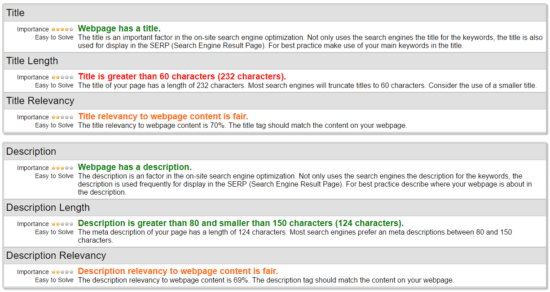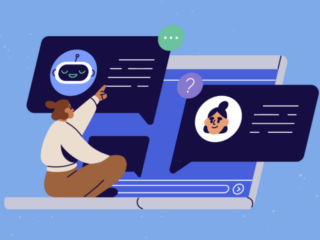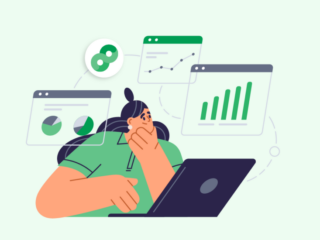Search engines must crawl and index trillions of pages and files across the web in order to return the most relevant results to match their users’ search queries. The two main influencers (determined by algorithms which are made up of many different ranking factors) are:
- Relevancy; this is the degree to which the content of the page matches the user’s query intention and search terms. Relevancy would increase if the page were to contain terms relevant to the phrase which the user searched for, or if links to the page are coming from relevant pages and use relevant anchor text.
- Importance; this refers to the page’s relative importance, measured through the links that refer to it. Importance would increase with every other external site, and the pages that reference it. An example of this would be, mentions and links back to your site on social media sites. This adds more granularity by helping the search engine to know whether to trust the site, and how much authority it has within an industry.
As you can see, search engines handle numerous complex tasks in order to provide relevant search results to their users. However, if you understand how to speak their language, you can manage to get – and stay – in their good graces.
Web page content
Search engine crawlers and indexing programs are very powerful, but make no mistake, they still have their limitations. First off, they will only understand some parts of most web pages in raw HTML form, and largely ignore code that is related to the navigation and display of the page, since it has nothing to do with the page’s unique content.
Specifically, they scan for the presence of keywords across particular HTML markups to define what the page is all about. The main way to communicate information about your page content with the search engine, is adding relevant keywords to these elements. This is what will ultimately increase the chances of your site showing up in related searches:
- The overall body of the text – keyword density will be important here, although too much can work against you;
- The page title tag – this is the second most important piece of content after the actual content of the page;
- The headings – H1, H2, H3 tags;
- The ALT attributes for images, as well as their file names, titles, descriptions and captions;
- The URL string: among other things, the search engine will look for keywords here as well, along with its length (an excessively long URL could penalize your search visibility);
- The meta description tag – which plays a key role, since search engines use them as part of the description for your page snippet. This has a significant influence on the click-through rate of your search listing which can impact your ranking, however the meta description content is not directly used by the search engines in their ranking algorithm;
Note: the meta keywords tag (list of keywords that you wish to have associated with the page) used to be an important factor to assert a page’s relevancy, however their value is now negligible because of their abusive use by spammers.
The page title, URL, and meta descriptions are especially important, as they are displayed as a snippet on the search engine results page, and are often the first impression you will make on your visitors and search engine’s crawlers alike:

Source: screenshot from Google’s search result page
To help you make sure your pages are properly optimized, there are different tools available such as Screaming Frog SEO for large batch analysis (up to 500 URLs at the same time for the free version):


Source: screenshots from Screaming Frog SEO
Alternatively, the free tool SEO Centro can be used for the same purpose, although it does not support batch analysis:

Source: screenshot from SEO Centro – SEO Analyzer

Source: screenshot from SEO Centro – Meta Tag Analyzer
Before getting up to speed on any of these markups, the first step is to establish a list of keywords that you want your site to show up for, and that you will implement across these areas of focus. To do so, think about the words users would typically use to find your pages, and include those words on your site. AdWords’ Keyword Planner can be a useful tool to help you uncover popular keywords for your industry:

Source: screenshot from Keyword Planner
You should absolutely verify also that your site has an XML sitemap; this will inform the search engines about all of the pages on your site that are available to crawl. While not having one is not penalized per se, it will ensure that all your pages will be indexed and ranked.
Content Quality
Search engines also attempt to measure the quality and uniqueness of a website’s content to rank it against others. Some of these can be considered ‘soft-influencers’, but you can stack the odds in your favor by:
- Proofreading your web pages for any spelling and grammatical errors. It is considered a quality signal, although it might not rank as high on the factors list.
- Avoiding duplicate content inside your pages and across your site. This is high priority, as identical content on the same site can negatively influence a site’s search engine visibility. Tools exist to help with this task, the previously mentioned Screaming Frog SEO, and Google Search

Source: screenshot from Google Search Console
- Maintaining the freshness of your content . Search engines can favor recently updated content, especially for time-sensitive searches, such as news coverage, new product releases, or time-limited discount deals.
- Establishing a reading level that is suited to the audience you are targeting. Different methodologies are used to determine it, based on factors such as word length or words per sentence. Keeping your audience in mind is key; and you may alter your content and reading level depending on whether your site is B2C or B2B, and the industry you are in.
These optimizations will also improve your visitor’s’ experience on your site, and with user engagement possibly being evaluated as part of the ranking process (still unconfirmed as of now) this could be a double-win!
Link Building
For many practitioners, link building is one of the most difficult aspects of SEO. It is ultimately the process of getting external pages to link back to your site. Intuitively, these incoming links are commonly referred to as “backlinks”.
Backlinks are important for SEO because some search engines give more credit to websites with a high number of quality backlinks. They can also analyze who is linking to your site to determine your website’s authority and trust – simply put, this is your popularity gauge. Several factors are involved when evaluating the value of these backlinks:
- The total number of backlinks, and the number of unique domains.
- The number of fresh/incoming links, and the rate of acquisition links. Note that a large increase in inbound links could be considered suspicious and ‘spammy’ by search engines.
- The authority of the site who linked back to you. The idea being that receiving a link from a well-known and relevant site would help boost your ranking, while a link from a lesser authoritative site might not count as much.
- Anchor text usage and variance – The anchor text used is also a strong signal to search engines, and if that text is keyword-rich or branded it can potentially do more for your ranking than if it was not.
A great free tool to quickly check in on these items is Moz:

Source: screenshot from Moz
Negative ranking factors
Finally, while spending time on optimizing the positive ranking factors is important, catching on those that could adversely affect your ranking should be on your priority list as well. The main negative factors that could hurt your positioning are:
- The presence of malware on your site.
- Applying cloaking – when the content shown on the search engine and the website is not the same.
- Having pages which have ‘sales’ links (ex: bit.ly), or content that advertises paid links on the site.
Experiencing slow page load time – which can be quickly checked with Google PageSpeed Insights:

Source: screenshot from PageSpeed Insights
Remember, search engine optimization is an on-going process, and even if most of the groundwork is done at the beginning, monitoring your site on a regular basis – especially as you create new content – is imperative!
If you’d like to learn more, or would like Cardinal Path to help you with an SEO audit, please contact us!



















